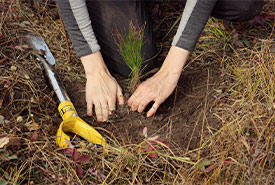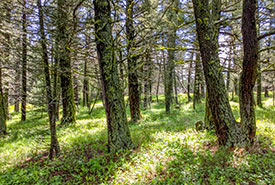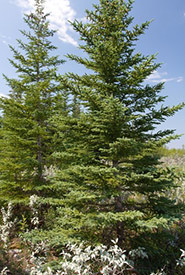Putting down roots: How NCC is contributing to 2 Billion Trees

Tree planting at Meeting Lake 03 (Photo by NCC)
When I feel the need to escape into nature, I often travel to my father’s cottage in Sauble Beach, Ontario. Located across the street from the beach, the cottage has stood in place for nearly 100 years. I thoroughly enjoy the cool breezes off Lake Huron and the spectacular sunsets, two things I don’t experience in my midtown apartment in Toronto.
In the 1950s, my grandparents planted several small cedar saplings at the back end of the lot to enhance their privacy at the cottage. Now mature, those cedars form a large and hollow grove. Over time, this grove has become a favourite escape of mine; it is where I can be found reading and napping on many a lazy afternoon. I enjoy its shady refuge after a sunny shift on the beach.
It occurred to me once that my shady escape is situated where the edge of a section of a large forest once was. This stretch of coastal forest was a super-highway for many species of birds and animals that called the shores of Lake Huron home. This idea can sometimes create a churning inner-conflict as I work through my sense of guilt by enjoying nature in a settled landscape. Conjuring up thoughts of my work at the Nature Conservancy of Canada (NCC) is the perfect antidote.
In my role as the government relations manager at NCC, I support communications activities related to several partnerships with government. These activities spread the good news of how NCC is accelerating conservation in Canada and restoring important landscapes like forests. One example is the Government of Canada’s 2 Billion Trees (2BT) program, which aims to plant two billion trees across Canada as one of many nature-based climate solutions to address Canada’s efforts to mitigate climate change. This initiative also contributes to global efforts to restore natural ecosystems, making the 2BT program especially significant as we progress through the UN Decade on Ecosystem Restoration.
Why plant trees?

Mature Douglas-fir trees on Bohomolec, Alberta (Photo by NCC)
When you look at a tree, what do you see? You may walk past a tract of woods without realizing some of the essential services that they can provide. Trees help take pollutants out of the atmosphere, sequester carbon dioxide, produce oxygen and provide homes for many species. They are also important for the physical health and well-being of people. But when it comes to restoring degraded habitats or expanding forested habitats, we must plant the right trees in the right places. In doing so, we support native ecosystems to enhance biodiversity and improve forest resilience to climate change. Planting trees is a key strategy to addressing the twin crises of biodiversity loss and climate change.
The importance of partnerships
NCC believes in the strength of collaborative partnerships. Examples of already successful public-private partnerships include the Ecological Gifts Program and Natural Heritage Conservation Program, of which NCC has been a trusted delivery partner since 1995 and 2007, respectively. Planting 2 billion trees is no small feat. Our participation fits well with NCC’s commitment to accelerate conservation in Canada, including meeting Canada’s 30 x 30 goal and lending expertise in conserving lands of high natural value.
What we’ve accomplished so far

White spruce (Photo by Samuel Brinker, iNaturalist, CC BY-NC 4.0)
Some examples of plantings that took place to date with funding from the 2BT program include Nebo, Saskatchewan, where more than 15,000 white spruce were planted to boost the west boreal transition region and at Saint-Andre-d’Argenteuil, Quebec, where a mix of 1,000 maples, birches and oaks were planted in the Montreal Greenbelt. In total, NCC successfully planted over 50,000 trees over 57 hectares and at 11 sites under the program in 2021. Stewardship activities, such as invasive species control, watering, and erecting barriers to deter browsing by grazers will help these trees mature and survive in the years to come.
Through the process of photosynthesis, these saplings have begun capturing and storing carbon dioxide. By releasing oxygen, they contribute to the air we breathe, while purifying it from pollutants. As they grow, they will start to provide homes to various forest critters. Some properties, such as Bunchberry Meadows in Alberta — where over 4,000 balsam poplars were planted — provide opportunities to explore this newly restored nature, contributing to mental well-being and physical health.
The 2BT program has only begun to support projects that will regenerate Canada's woodland habitats. It is exciting to know that many other organizations are also being supported through the program to fund their own tree planting programs across Canada. I'm also reminded of the countless number of Canadians planting trees on their properties, perhaps unknowingly planting a future space where someone will nap and read and wonder about the natural space around them.
This project was supported with funding from the Government of Canada’s 2 Billion Trees program.

